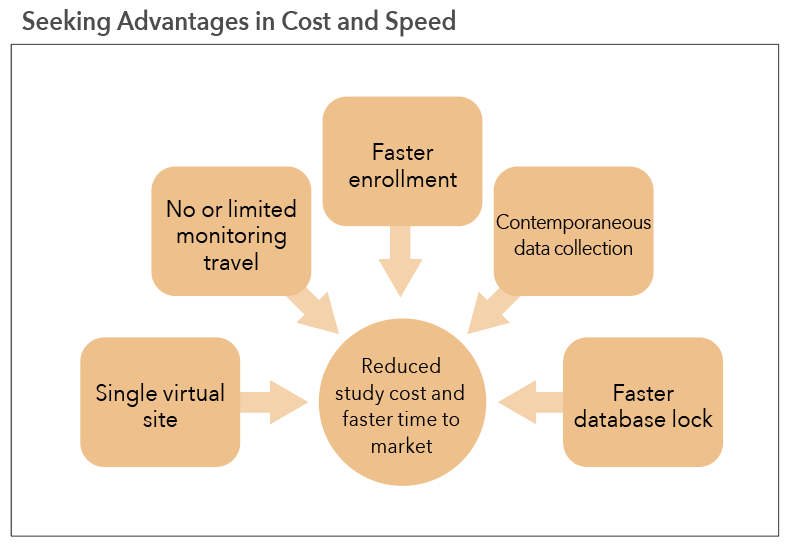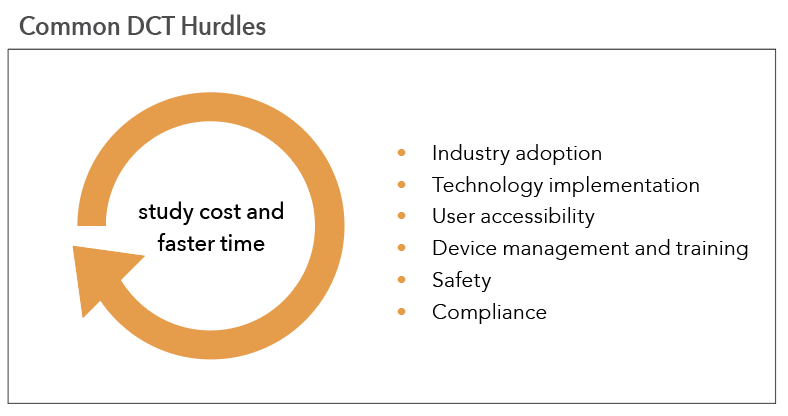Budgets and Billing in Clinical Trials: DCT Considerations
Cost strategies for medical device trials in the new era of digital health.

Clinical trials generate the evidence required to enable the marketing of safe and effective medical devices. The clinical trials market size has been growing despite the COVID-19 pandemic in 2019-2022, and the trend is expected to continue.
Industry and global regulators acknowledge the need to conduct clinical trials more efficiently and cost-effectively to bring innovative healthcare products to patients more quickly. Recently, FDA released several draft guidances related to decentralized clinical trials (DCTs) and digital health technologies (DHTs), encouraging industry sponsors, investigators, and other key stakeholders such as contract research organizations (CROs) as well as technology providers to increase adoption and implementation for faster trials.
The pandemic motivated DCT adoption, a key tool for implementing a faster trial.
Sponsor cost and budget considerations
The industry is expected to harness big data to optimize planning and predictability and proactively identify risks, to better understand costs per patient and impact of patient recruitment and retention. In 2023, DCTs have moved toward patient flexibility by utilizing digital tools.
Not all trials are suited for a decentralized approach. Studies requiring specialized physical assessments or a trial involving an implantable device need to utilize physical investigational sites. The active phase of these studies is conducted in a highly specialized environment. The possibility exists, however, of using a decentralized approach for long-term follow-up of patients conducted using new technologies that can transfer information to the investigator or sponsor via remote technologies. Trials such as blood pressure monitoring, post-surgical pain management, or wearable glucose monitoring are examples that are highly suitable for DCTs.
Clinical trials comprise an enormous percentage of any new medical product development budget.1 The new era of DHTs and DCTs allows for potential cost reductions. Consider the following cost drivers of potential cost savings:
1. Clinical trial strategy planning
- Improvements in FDA review efficiencies and interactions to reduce the time from study design to study approval.
- Identification of risks and development of mitigation plans.
- Identify technology vendors with competitive pricing, validated and compliant platforms, and price negotiations.
- Staged regulatory approval to reduce/limit patient population for the initial approval followed by expansion.
2. Protocol design optimization
- Optimization of study design by:
- Adequate inclusion-exclusion criteria.
- Using control arm directly from electronic health record (EHR) data.
- Utilizing an adaptive design.
- Simplifying the protocol by:
- Reducing data collection.
- Reducing the number of protocol amendments.
- Design endpoints with reduce threshold for initial regulatory approval/clearance.
3. Faster site identification and activation by:
- Partnering with site groups with a wide geographical area and diverse population.
- Identify community-care sites and engage with them for diversity and inclusion enrollment.
- Ensure rapid site activation and patient access.
4. Patient identification and recruitment enhancements by:
- Utilization of patient-facing technologies that identify interested potential participants.
- Using technologies that pre-screen potential participants based on qualifying questions.
- Use of technologies that can be HER add-ons that match patients with the trial and alert investigator or study team.
5. Patient retention, engagement, and compliance using DHTs such as:
- eConsent.
- Telemedicine platforms for audio/video visits, schedule tracking, remote assessments.
- DHTs for patient-reported outcomes (PROs), safety surveillance, and compliance.
6. Trial operations and monitoring optimization
- Optimize study start-up by:
- Use of a centralized institutional review board (IRB).
- Standardizing site contracts.
- Use DHTs such as wearables, home health monitoring, and ePRO to collect data faster and reduce source document verification (SDV) and time to data lock.
7. Data management optimization by:
- Partnering with technology vendors to enable data exchange across systems, such as EHRs and electronic data capture (EDC) or with application programming interface (API)-enabled architecture for digital trials systems for seamless data transfer.
Budget trends in DCTs and virtual clinical trials
Budget projections for medical device development-to-launch costs are expected to increase by 4.7% by 2028.2 Class III premarket approval (PMA) devices are expected to have the highest cost of 50% more than for Class II 510K products,6 and Class II home diagnostics products budgets are expected to grow by 5.1% by 2030.5
Similarly, pharmaceutical industry trial budgets are expected to increase by 5.6% until 2032, as noted in a report by Precedence Research.4
Visiongain reports that the DCT market is expected to grow 7.6% by 2033 due to increased use of DHT and home healthcare.7 The number of trials with virtual, decentralized, or some decentralized features continues to increase globally.3 In the US, by 2024, about 75% of trials will use remote patient monitoring and by 2025, the virtual market is expected to growth by 13%.4
Advantages and challenges for a DCT with a tight budget
With the rising number of clinical trials and increased costs for development-to-launch, the industry is moving to DCTs and DHTs, using registries and real-world evidence data to reduce the cost of trials.
The main advantages of DCTs are show in Figure 1 and include:
- Reduced sponsor study cost. A single virtual site, no monitoring travel required, faster enrollment, contemporaneous data collection, and faster database lock translate into cost savings.
- Reduced time to regulatory submission. With the DCT advantages, faster trial completion means reduced time to regulatory submission for the product and faster time to market.
Figure 1. The major benefits of decentralized clinical trials.
Source: MEDIcept, Inc.

If the clinical trial design is suited for a DCT study, the challenges should also be given very careful consideration (see Figure 2 below).
Figure 2. Key challenges associated with DCT implementation.
Source: MEDIcept, Inc.

To address the challenges, sponsors should be aware of associated costs of technologies employed in the trial by ensuring that the technologies chosen are validated and offer data security and privacy of personal health information. Partnering with technology and digital health companies may provide some future cost savings.
Virtual trial example
A virtual trial was conducted for a home use device intended to reduce anxiety.
Patient identification was led via social media platform study advertising, which allowed interested participants to sign in and respond to pre-screening trial-specific questions for eligibility. Eligible participants were enrolled by a study healthcare professional (HCP) during a telehealth visit.
The investigational products were shipped directly from the sponsor-designated person directly to the patients’ homes. Training was virtual via video platform.
The study was IRB-approved centrally and the CRO served as the designated single site, managing the study virtually by assessing the anxiety level at different visits by a HCP via a telehealth platform and a self-reported patient outcome questionnaire through an eDiary and ePRO platform.
The study visits were tracked by an automatic scheduler and emails reminders were sent automatically to the participants. Monitoring was reduced due to the very few assessments needed to be source verified. Safety was assessed by self-reported outcomes by participants and reviewed by the CRO safety officer.
For this virtual trial, the sponsor study cost savings included:
- Site budgets were non-existent: no cost for start-up, no site IRB submission, no site administration, no device storage and archiving.
- Patient recruitment and enrollment costs were limited to the platform used to deploy IRB approved materials to social media.
- Study monitoring costs were significantly reduced since they were only related to documentation collected by the CRO in the trial master file. There were no site-monitoring visits and associated travel costs.
- Data management costs were reduced, as there were no site queries or other vendor-related queries and no external data transfer and reconciliation.
As with any trial, challenges arose. Challenges associated with the study’s virtual nature included:
- Some subjects were slow to adopt the digital technology employed to perform study functions.
- Patient compliance with the data entry, including reporting adverse events, required more sustained tracking and follow-up from the CRO.
Decentralized hybrid trial example
A decentralized hybrid trial was conducted for a home use device intended for pain management of the extremities. The study was IRB-approved centrally and the sites accepted the central IRB.
The study was managed by a CRO in hybrid mode. Patient identification was conducted by each of the participant sites as determined by the HCP. The CRO determined group allocation to the device or the standard of care. The device group received the devices shipped directly to the patients’ homes. Device training was conducted by an online video platform.
Both participant groups reported pain scale daily by completing a questionnaire via an ePRO platform.
The study visits were tracked by sites and the CRO. Monitoring was reduced due to the limited number of assessments to be source verified from the sites. Safety was assessed by self-reported outcomes by participants and reviewed by the site staff.
The study cost savings were experienced in the following areas:
- Site cost was reduced: no device storage.
- Patient recruitment and enrollment cost was limited to the site’s patient pool by protocol.
- Study monitoring costs were reduced to only site-related data entry.
- Data management was reduced due to no vendor queries, lab or imaging data and no external data transfer and reconciliation.
Challenges associated with this study included:
- Selection of sites who had the appropriate patients to report data utilizing DHTs.
- Patient adoption of the digital technology employed to perform study functions.
- Patient compliance with the data entry, including reporting adverse events, required more sustained tracking and follow-up from the CRO.
Billing compliance and risks
While there are many differences between pharmaceutical and medical device industry trials, one major difference surrounds whether or not the study product is billed to insurance.
While an investigational drug is provided for free and not billed to insurance, an investigational device may be reimbursable. The Medicare Prescription Drug, Improvement, and Modernization Act of 2003 (MMA) allowed Medicare payment of the routine costs of care furnished to Medicare beneficiaries in certain categories of investigational device exemption (IDE) studies.
The study sponsor should assess the device reimbursement and whether its Centers for Medicare & Medicaid Services (CMS) device category falls into:
- IDE Device Category A (experimental device), is not reimbursable (42 CFR 405.201b).
- IDE Device Category B (investigational device), is billable “at cost.”
CMS requires pre-authorization for covering the trial costs and billing, which should adhere to Medicare reporting requirements (i.e., “extended coverage” per the National Coverage Determination [NCD] 310.1 guide).
In any trial, billing issues may arise and the most common reasons include double-billing, deeming a clinical trial qualified or routine when it is not, and falsely billing non-covered items/services or when patients were not seen.
To mitigate these risks, sponsors should ensure they collect the key documents and perform a coverage analysis, which should include identifying every subject on every study for every visit, performing a full bill hold for all subjects, working through all institutional claims and invoices, and reviewing for correct billing and that coding is applied properly.
Seizing the opportunity
The number of DCTs is expected to increase due to the industry’s need for faster, more accessible, and cost-effective solutions to deliver medical innovations to patients. Sponsor companies conducting clinical trials should consider engaging in DCTs when possible and leverage various DHTs to reduce cost. When budgeting a trial, sponsors should pursue cost savings while addressing DCTs’ challenges with the following solutions:
- Ensure adequate risk-mitigation plans.
- Select the appropriate technology.
- Address user accessibility.
- Utilize appropriate device management and training tools.
- Leverage technologies to facilitate direct data transition to the clinical/medical staff or enable HCPs to visit the patients in their homes to monitor and ensure safety.
- Use of available technologies for close monitoring of study and patients.
Adelina Paunescu, PhD, VP of clinical affairs, MEDIcept, Inc.
References
- Therapeutic Complex Medical Device Development. ERG Inc. report to US HHS. October 15, 2022. https://aspe.hhs.gov/sites/default/files/documents/4d80ac6f010cc681973299f4dee519ca/therapeutic-complex-medical-device-development.pdf
- Medical Devices – United States. Statista. November 2022. https://www.statista.com/outlook/hmo/medical-technology/medical-devices/united-states
- Virtual Clinical Trials Market: Decentralized Clinical Trials/Virtual Clinical Trials Market (2nd Edition) - Distribution by Therapeutic Area, Phase of Development (Phase I, Phase II, Phase III, and Phase IV), and Key Geographical Regions: Industry Trends and Global Forecasts, 2023-2035. Roots Analysis Business Research and Consulting. April 2023. https://www.rootsanalysis.com/reports/virtual-clinical-trial-service-provides-market.html
- Clinical Trials Market – Global Market Size, Share, Trends Analysis, Segment Forecasts, Regional Outlook 2023-2032 Precedence Research. December 2022. https://www.precedenceresearch.com/clinical-trials-market
- US Healthcare Industry in 2023: Analysis of the Health Sector, Healthcare Trends, & Future of Digital Health. Insider Intelligence. January 1, 2023. https://www.insiderintelligence.com/insights/healthcare-industry/
- Sertkaya, A.; DeVries, R.; Jessup, A.; Beleche, T. Estimated Cost of Developing a Therapeutic Complex Medical Device in the US. JAMA Network Open. 2022. 5 (9). https://jamanetwork.com/journals/jamanetworkopen/fullarticle/2796179
- Decentralized Clinical Trials Market Report 2023-2033. Visiongain. April 2023. https://www.visiongain.com/report/decentralised-clinical-trials-market-2023/

Putting Collective Insights Into Action to Advance Cancer Care: Key Examples From ASCO 2025
June 27th 2025At ASCO 2025, clinical operations leaders gained critical insights into how AI tools, bispecific antibodies, and evolving treatment paradigms are reshaping trial design, endpoint selection, and patient stratification.
What Can ClinOps Learn from Pre-Clinical?
August 10th 2021Dr. Hanne Bak, Senior Vice President of Preclinical Manufacturing and Process Development at Regeneron speaks about her role at the company as well as their work with monoclonal antibodies, the regulatory side of manufacturing, and more.
2025 DIA Annual Meeting: Why AI and Automation Are Set to Become the New Normal in Clinical Research
June 20th 2025Peter Ronco, CEO, Emmes, shares his long-term vision for artificial intelligence in clinical research, from making automation routine to improving drug discovery, transforming regulatory oversight, reducing animal testing, and promoting ethical, equitable data use worldwide.